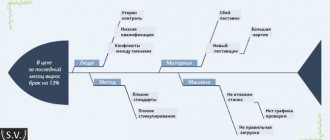“Talent wins games, and teams win championships.” That's what Michael Jordan once said and he was right. Any successful decision, be it a championship won or the release of a new product in an IT team, is achieved through the efforts of each individual. Where does the team path to success begin? Remember the Latvian group Brainstorm with its popular hit Maybe from the early 2000s? A good group, but this article is about another brainstorm. One that, with a quality approach, can become a constant hit in your team’s workdays and the beginning of great success and global results.
Brainstorming or brainstorming
is an effective way to solve problems and current tasks, based on stimulating the creative activity of team members. The goal of brainstorming is to generate as many ideas as possible and determine the best solution in different ways. Ordinary brainstorming can become a turning point in the fate of a project or an entire product.
How often have the coolest and most profitable projects started in your team with a simple brainstorming session? Is it worth using brainstorming as a systematic practice in the working life of a team? In the Hygger.io team, brainstorming is not a must-have practice, but is carried out regularly. If you approach this process correctly, it will no longer be a waste of time.
What are the features of brainstorming in Agile teams?
Essentially, Agile team brainstorming focuses on the same general goals as any other brainstorming session.
The differences are in the team, where the core of the participants are developers. There is no need to confuse brainstorming with daily stand up. Daily Stand Up
(daily team meetings) is an event that takes place in Kanban, Scrum, Extreme Programming or other teams to synchronize actions and discuss statuses on short-term tasks.
Stand Up should not turn into a brainstorming session, since it has time limits set by product managers or project managers (most often, 10-15 minutes).
Brainstorming in Agile teams is a more thorough and detailed event with the specific goal of finding solutions.
During a brainstorming session, discussion participants are encouraged to express as many options as possible for solving the issue. As a result of practice, several solutions that are most suitable for the problem are selected.
Who is the author of the brainstorming method?
Brainstorming was created by Alex Osborne. He had an interesting and eventful life. He worked at a construction site, as a messenger, and as a clerk to earn money for his studies. From the age of 21 he was a police reporter, salesman, teacher. The next position is assistant manager at the plant.
And finally, Osborne became a co-owner of a large company. In 1937, he came up with the brainstorming method. Before telling the public about it, I successfully used it for 2 decades.
Alex Osborne called the creation "brainstorming". The word is translated differently. These are “unexpected brilliant idea”, “crazy idea”, “great plan”, etc.
Advantages and disadvantages of the brainstorming method
Like any other technique, brainstorming has pros and cons. The advantages include:
- Creative thinking develops.
- All participants have to be actively involved in the work.
- One of the tasks of brainstorming is to push the boundaries of consciousness.
- Participants interact with each other.
- Brainstorming technology is easy to use and does not require any equipment or premises.
Interestingly, brainstorming as a learning method is applicable not only to adults. It is often used at school and even in kindergarten. It stimulates creative activity, activates the learning process, helps children form their own opinions and interact with each other.
The disadvantages include:
- As stated above, all group members should actively participate in the discussion. But it happens that only a couple of people work. The others wait silently for the process to end.
- Due to the abundance of ideas and solutions, the event often stretches for several hours.
- The method will be ineffective if the participants do not know how to work in a team and interact with each other.
- Sometimes experienced employees try to become leaders in discussions by overpowering less experienced colleagues.
Also during brainstorming you need to follow a number of rules. Ignoring them nullifies attempts to find a solution to a problem or task.
Zero draft
The zero draft is an idea generation technique often used by writers and is essentially a form of focused free writing. For marketers, it will help you focus on the early stages of a new project by establishing what you currently know and getting your initial ideas out of your brain and onto paper.
— Write what you now know about the subject.
— Write what you don’t know, but need.
- Think about why this is important.
- Write down all the ideas you have on this issue.
The Zero Draft method is to write down everything you think about a topic, no matter how chaotically. The goal is to overcome the initial block.
Popular types of brainstorming
There are several types of brainstorming. They differ in the technique of conducting, the role of the participants, and the results.
Brainwriting
For 15 minutes, team members write down ideas, but do not speak them out loud. The leaf is passed around in a circle. Participants, having read the previous sentence, add something of their own. The main goal is to put forward as many proposals as possible. However, you cannot criticize until the event is over.
Brainstorming on a whiteboard
The board is placed in a visible place. As soon as an idea comes into the head of a manager or another employee, he writes it down on a piece of paper and pins it on the board.
In Japanese
This type of brainstorming was created by the Japanese Kawakita and Kobayashi. Otherwise called “rice hail”. The point is that the participants use the same approach to solve the problem. The workflow consists of several stages:
- The first step is to identify the problem. The presenter presents the details and nuances of the topic being discussed. Participants write down their thoughts on the problem being solved on separate pieces of paper. Moreover, this is done in such a way that everyone leaves a note on all pieces of paper. Then you need to select records related to each other and hand them over to the presenter. He will read it aloud. All that remains is to come up with a name for each set. It should reflect the essence of the problem.
- Searching of decisions. The stage is similar to the previous one. Only this time, participants write down ideas for solving the problem. At the end they are grouped into sets. Each set is given a name that expresses the general essence of the proposals. The purpose of this part of brainstorming is to identify constructive ideas that are appropriate to the current situation.
Collective work in this case brings group members closer together, teaches them to work together with colleagues, and understand their position.
Multistage
In short, there are 2 groups working here:
- those who create ideas;
- those who evaluate the results of work.
It is desirable that the first group should include erudite people with the same temperament. They must fully understand the essence of the problem. 10 people are enough.
Recruit those who will analyze the proposals invented by the “generators” into the evaluation group. It should include a representative from management. This person will make decisions about the implementation of positively evaluated ideas.
A leader is assigned to each group. His main qualities are delicacy and erudition. It depends on them how quickly participants find the right idea.
A multi-stage assault looks like this:
- Members of the first group express ideas.
- The task remains the same, but new, non-standard approaches are needed. You can put forward the opposite of what is named.
- The second group is connected. It brings together everything that was said in the first stages, systematizes information, and looks for solutions to the problem.
- The difficulties that may arise when bringing ideas to life are discussed.
- The proposals made are collected into several principles.
The last stage is the most interesting. This is a discussion during which all previously proposed ideas are broken down. You only need to criticize them, not the participants. The names of the latter should not be mentioned. It is important that the process takes place without development customers. Only in this way will the work give the desired results.
Word bank
Word associations often focus on pairs of words, word associations asking you to form large groups of terms that describe only a few topics. Creating word banks in a business setting can help you divide a project into manageable chunks—sort of like a mind map.
Once your working bank is ready, you can form connections between the terms you come up with and use those connections to generate ideas that are guaranteed to include all of your most important characteristics.
A word bank is ideal for content projects and can be a precursor to deeper keyword research.
Stages of classic brainstorming
Generating ideas using brainstorming takes place in 3 stages:
- Definition of the problem. This is preliminary preparation for work. During it, participants are assigned roles. Someone will be the leader, someone will be the assistant, etc.
- Searching of decisions. This stage can be considered the most important. The result depends on it. For maximum efficiency, some rules should be followed. Firstly, you shouldn’t limit your imagination. Come up with any unusual and even absurd ideas. Secondly, the proposals made can be combined with each other, improving them. And thirdly, you cannot evaluate or criticize what the participants said.
- The third stage is grouping and evaluating ideas. It is often ignored. And that's wrong. It is at this moment that suitable ideas are highlighted, the whole process is reduced to a single result.
The success of all stages depends on how coordinated the participants can work. Their opinion regarding the problem and ways to solve it is also important.
Historical reference
Despite the fact that brainstorming as a method appeared relatively recently, the technique of step-by-step problem solving itself was described in the literature long before Osborne - about 2 thousand years ago!
A two-stage approach to solving problems was described by the ancient Roman historian Cornelius Tacitus, who studied the life of the Germans. In his works, he described how during feasts they discussed important issues for their people about the reconciliation of warring parties, the promotion of leaders, and marriages. They believed that it was in this state that the soul was more inclined to frankness. The next day the same conversations were resumed, but with a clearer mind.
More than 100 cool lessons, tests and exercises for brain development
Start developing
An even older example that shows signs of brainstorming techniques can be found in 700–600 BC. e. in the Roman province of Bithynia (the territory of modern Turkey). According to historians, local residents had a custom: when faced with a disease that they did not know how or how to treat, members of the patient’s family brought it out for everyone to see. So any passerby could share their opinions and experiences on what a person might be suffering from and what to do about it.
They resorted to this method not only in matters of health, but also in any other situations: people were interviewed on the streets and the most acceptable ones were chosen from all the assumptions voiced.
Who to trust to conduct brainstorming
The effectiveness of the group depends on who is doing the brainstorming. Therefore, place in this role people who can think creatively, analytically, logically, and also respond correctly to criticism and comments. It is also important that they enjoy the authority and respect of their colleagues. The group leader has a number of responsibilities:
- Decide what type of brainstorming is needed at the moment.
- Gather participants into groups.
- Define the problem at the ideation stage.
- Provide the conditions necessary for the active work of each individual participant.
- Systematize and analyze ideas.
The leader also evaluates the results of the brainstorming session. He decides to implement them in practice.
Storyboard
If you're trying to design a process, a storyboard can help you see where your collective understanding of the problem supports or contradicts the proposed solution, and where more research is needed. By developing a visual story to explore a problem, your team can see how ideas interact and connect to form a solution.
Notes are your friend. Take a few minutes to write down your ideas as individual notes. Once you have a group of sticky notes to work with, start laying them out sequentially on the board. This will help you see new connections.
Storyboarding is especially useful for marketers. With it you can:
— Describe the sequential process of a marketing campaign.
— Improve internal processes by describing specific steps.
— Make a storyboard for an advertising video.
Is it possible to brainstorm online?
There is an opinion that a personal meeting is the best option for brainstorming. But in practice it has been proven that communication via Skype, on forums or in chat rooms is no less effective. And sometimes it gives a greater effect. Why is this happening? There are several reasons:
- Many people are embarrassed to participate in discussions. The calm atmosphere during online brainstorming encourages them to create unusual, unique ideas.
- The proposed solutions are immediately recorded.
- In a chat or forum, team members can speak simultaneously.
- This method of brainstorming requires minimal effort.
- The resulting ideas and solutions are easier to process.
When hosting an event online, it is also important to follow the basic rules. The main thing is that the ideas expressed cannot be criticized.
Mind map
Many types of software provide automated mind mapping templates for better organization of data. This is also a great way to organize your ideas.
— Write your problem on a piece of paper.
- Surround it with terms that describe what you need.
— Describe how you could solve these problems.
- Keep adding layers until you understand the problem completely.
This is a fantastic problem-solving technique that encourages creative responses. In marketing, you can use mind maps to solve problems:
— Create content maps for your entire blog or site. You can start with a general topic and then start creating branches for each subtopic.
— Come up with marketing campaign ideas divided into main topics and subtopics.
- Create yes/no scenarios to place different lead segments into specific drip campaigns.
Rules for conducting effective brainstorming
As stated above, the effectiveness of brainstorming largely depends on compliance with the rules for its conduct. There are only 10 of them:
- Preparation is a must. It starts a couple of days before the event. This gives participants the opportunity to explore the problem in advance and find solutions to it.
- As many people as possible should participate in the brainstorming session. Many participants - many ideas.
- The task assigned to the working groups must be thoroughly studied. This will help you see its essence. Participants will be on the same wavelength. There will be no misunderstandings or contradictions.
- Everyone participating in the brainstorming session should take notes. Most often, this responsibility is assigned to the leader. But he is also a person, he misses something or does not notice. Therefore, it is better if participants also take notes.
- This rule can safely be called the most important - do not criticize. You should not condemn, even if what a person says seems stupid or absurd. Maybe this proposal, after revision and improvement, will be implemented in life. Remember: criticism can discourage a person from continuing the discussion. And this cannot be allowed.
- If you're a member, offer more options. Do not be shy. Voice every thought that comes to your mind. Do this even when it seems that the best offer has already been made.
- Involve additional participants to get ideas. Let these be strangers or employees who do not take part in the event.
- Combine ideas with each other. This advice is especially successful if proposals are made by people of different ranks, specialties, and positions.
- To make information easier to perceive, use posters, diagrams, and boards.
- Simulate a situation in which everything does not go as expected. Now think about how to turn it in your direction? Find more options. Prepare yourself for such a turn of events psychologically and morally.
These rules of brainstorming should always be followed, regardless of the field. This could be work, personal and family relationships, business. Take time to organize the process. Take into account its nuances and features. This is how you will find a way out of any situation.
How to choose the right idea?
After brainstorming, there are still a ton of ideas that need to be organized and sorted. If it is clearly difficult to implement the plan, cross it out; if you do not have enough resources (and no real sources), cross it out; if no one is interested, cross it out. There are a number of questions you can ask yourself:
- How quickly can this be accomplished?
- How big is the payoff?
- Is it easy to do?
- Is it cheap?
- Risky?
- What does your fifth point... sixth sense tell you?
Alternatively, you can use a modified SWOT matrix to evaluate ideas. To do this, you need to write down all the solutions received in a list, number it and consider each one separately.
To narrow down the circle of “suspects,” you can ask each participant to choose the TOP 5 ideas. It is important that the lists are anonymous - at this stage groupthink will only cause harm.
Examples of brainstorming
Imagine a ship on which you need to transport iron ore concentrate. Transportation causes a lot of problems because the cargo behaves like a liquid. When the ship rolls or rolls, it flows from one side to the other. Brainstormers need to eliminate this shortcoming.
The facilitator reminds the team not to criticize the ideas expressed. 6 experts put forward solutions to the problem:
- Pour the load to the edge. In this case, there is nowhere for it to flow.
- Press down the concentrate with large shields.
- Using partitions, divide the hold into several parts.
- Spray with polyurethane foam liquid. This is done when transporting grain.
- Wet the load and then freeze it.
- Magnetize.
- Place a pillow under the load. Inflate it with air. It will rise and press the concentrate tightly against the ceiling.
Participants list dozens of ideas. According to the rules, they cannot be stopped. But the presenter suggests moving on to the next stage - criticism. This is where the analyst comes into the conversation. Through discussions, the team realizes that the idea of shields and partitions is not suitable. Suggestion to use air pillows too. They will have to be inflated using an on-board compressor. All together the equipment will be too heavy.
The “magnetic” idea turns out to be the most suitable. Participants propose hanging magnets around the perimeter of the hold in the form of a garland. They can be turned on and off if necessary.
When are brainstorms needed?
It seems that any problem can be solved using a brainstorm, but this is a misconception. For assaults, questions are needed, the exact answers to which no one knows, and the solution to the problem posed has several options, each of which requires discussion.
First of all, storming is needed in order to throw together many different ideas and choose the most optimal ones. At the same time, one person or a small group is responsible for their implementation, but not all participants in the brainstorm, because otherwise the idea is blurred and no one understands where the team is heading. Let's say we need to decide on a communication strategy - this is a large project that is divided into many subtasks. If you distribute them to several specialists at once, a unified picture will not emerge, and the overall goal will not be achieved.
If employees imagine one big task in different ways and no one knows how best to complete it, a brainstorm is needed
Let me give you an everyday example. What to give a friend for his birthday? To solve this issue, you can get together with friends and organize a small storm, because everyone thinks differently. Perhaps some people will come up with the same ideas, or some will come up with a solution that outshines all others.











